Fire damage can destroy a property in the blink of an eye—burning through walls, furniture, and memories. The destruction is fast, intense, and obvious. But what about water damage? It’s quiet, often hidden, and unfolds slowly behind walls or under floors. And yet, it can be just as devastating—if not more—over time.
When disaster strikes, many property owners ask the same question: Which causes more long-term issues—fire damage or water damage? In this guide, we break it all down. From structural harm to health risks, cost comparisons to restoration complexity, we’ll explore which threat lingers longer and hits harder in the long run.
Quick Comparison – Fire Damage vs Water Damage
- Fire Damage: Usually sudden and catastrophic. It burns, melts, and chars everything in its path. The immediate aftermath includes destruction, smoke contamination, and chemical residue.
- Water Damage: Often starts subtly—from a small leak, a burst pipe, or heavy flooding. But its ability to seep into every crevice makes it a silent threat, with the potential to weaken structural integrity over time.
The difference lies in visibility and timing—fire shouts, water whispers. But which one truly leaves a longer mark?
Fire Damage – What Really Happens After the Flames
Smoke and Soot Infiltration
When fire burns materials—especially synthetic ones—it releases smoke and soot that settle on every surface. This residue is acidic, sticky, and toxic. It penetrates deep into drywall, insulation, HVAC systems, and personal items, leaving behind lasting odors and corrosion.
Structural Weakening
Extreme heat can warp metal, crack concrete, and char wood framing. Even areas not directly touched by flames may have suffered heat-related damage. Over time, these weakened materials can compromise the safety and stability of the building.
Chemical Residue and Corrosion
Fire damage isn’t just black marks and ashes. It leaves behind chemical residues that corrode wiring, destroy appliances, and cause electronic failure. The corrosive nature of fire’s byproducts means even “untouched” areas can degrade rapidly.
Water Damage – A Hidden Menace
Mold Growth and Infestation
Mold thrives in damp, dark places—and it doesn’t take long to show up after water damage. In fact, mold can begin growing within 24 to 48 hours. It often spreads behind walls and under flooring, going unnoticed until the infestation is severe.
Rot and Decomposition
Wood swells and rots when exposed to moisture. Drywall disintegrates. Insulation clumps and becomes useless. Over time, this deterioration can turn a livable space into a hazardous one—especially if the water damage was hidden for weeks or months.
Foundation Instability
One of the most serious consequences of prolonged water damage is foundation weakening. Water that seeps into the ground beneath your home can erode the soil and cause shifting, leading to cracks in walls, uneven floors, and structural imbalance.
Health Hazards – Invisible but Dangerous
Toxic Residue from Fires
After a fire, the air is filled with invisible toxins. These include carbon monoxide, formaldehyde, and other harmful compounds from burnt plastics and household items. Lingering particles can aggravate asthma, trigger respiratory issues, and lower indoor air quality long-term.
Mold-Related Illnesses
Mold is more than a nuisance—it’s a health threat. Spores can cause allergic reactions, skin irritation, eye problems, and serious lung infections. Those with compromised immune systems, including children and the elderly, are especially at risk.
Restoration Challenges – What It Takes to Recover
Duration and Complexity
Fire damage restoration involves removal of debris, deodorization, soot cleanup, and often major structural repairs. Water damage restoration might seem simpler, but the process of drying, dehumidifying, treating mold, and checking structural integrity is lengthy and meticulous.
Costs That Add Up
- Fire Damage: Higher up-front costs due to demolition, structural rebuilding, and replacing large items.
- Water Damage: Long-term costs from mold remediation, hidden damage repairs, and repeated insurance claims.
In many cases, water damage becomes more expensive over time because the issues aren’t immediately visible—and they just keep growing.
Insurance Barriers
Insurance tends to cover fire damage more comprehensively than water damage. While fire is typically seen as an unavoidable disaster, water damage—especially from leaks or neglect—may not be fully covered. Policies often exclude “gradual damage,” leaving owners to cover the costs themselves.
Prevention – Catching It Before It Spreads
Fire Detection and Suppression
Smoke detectors, fire extinguishers, and sprinkler systems are your best friends. Schedule regular electrical inspections, avoid overloading outlets, and never leave open flames unattended.
Water Monitoring and Leak Control
Install leak sensors near appliances, under sinks, and around the water heater. Smart home systems can notify you of moisture the moment it’s detected. Routine plumbing checks and proper drainage maintenance are essential for prevention.
Restoration Pros – Why You Need Experts
What Professionals Actually Do
Fire and water damage restoration professionals bring more than elbow grease. They use thermal imaging, industrial dehumidifiers, air scrubbers, ozone machines, and specialized cleaning agents to ensure complete recovery. They also help with documentation for insurance and ensure that no hidden damage is left behind.
How to Choose the Right Team
Look for:
- IICRC certification
- 24/7 emergency response
- Positive reviews and local experience
- Detailed estimates and transparent pricing
Don’t trust your property to just anyone. Restoration is a science—and the wrong team can cost you even more.
The Verdict – Which Damage Lasts Longer?
While fire damage is terrifying and highly visible, water damage tends to have longer-term consequences. Why?
- It spreads silently.
- It affects more systems (electrical, structural, HVAC).
- It invites mold, rot, and health hazards.
- It’s often not covered entirely by insurance.
- It’s harder to detect and eliminate completely.
Fire damage may look worse in the moment, but water damage is like rust—it eats away slowly until major repairs are needed. And often, you won’t know the full extent until it’s too late.
Final Words for Homeowners and Property Managers
Both fire damage and water damage require swift, professional action. But if you’re looking for the more persistent threat—it’s water. Its ability to hide and destroy from within makes it one of the most underestimated dangers to your home.
Invest in prevention. Don’t delay inspections. And when disaster strikes, bring in the experts fast. It’s not just about restoring a building—it’s about protecting your peace of mind.
Conclusion
Fire scorches. Water seeps. One strikes loud and fast, the other lingers and spreads. But when it comes to lasting, costly consequences—water damage often causes more long-term problems than fire damage.
It’s not just about what you see today—it’s about what might be growing behind your walls tomorrow. The smart move? Stay informed. Act quickly. And always treat water damage as seriously as a fire.
FAQs
1. Which causes more health problems: fire damage or water damage?
Both are hazardous, but water damage often leads to mold growth, which can cause persistent respiratory and allergic reactions.
2. Can fire and water damage happen together?
Yes. In fact, most fire incidents are followed by water damage from firefighting efforts, which can complicate restoration.
3. Is smoke damage just a cosmetic issue?
Not at all. Smoke particles are corrosive and toxic. They can damage electronics, HVAC systems, and air quality.
4. Can small water leaks really cause structural damage?
Absolutely. Even a minor, untreated leak can lead to rot, mold, and eventual foundation problems over time.
5. What should I do first after noticing damage?
Turn off the source (water or electricity), document everything, contact your insurance, and call a certified restoration team immediately.



